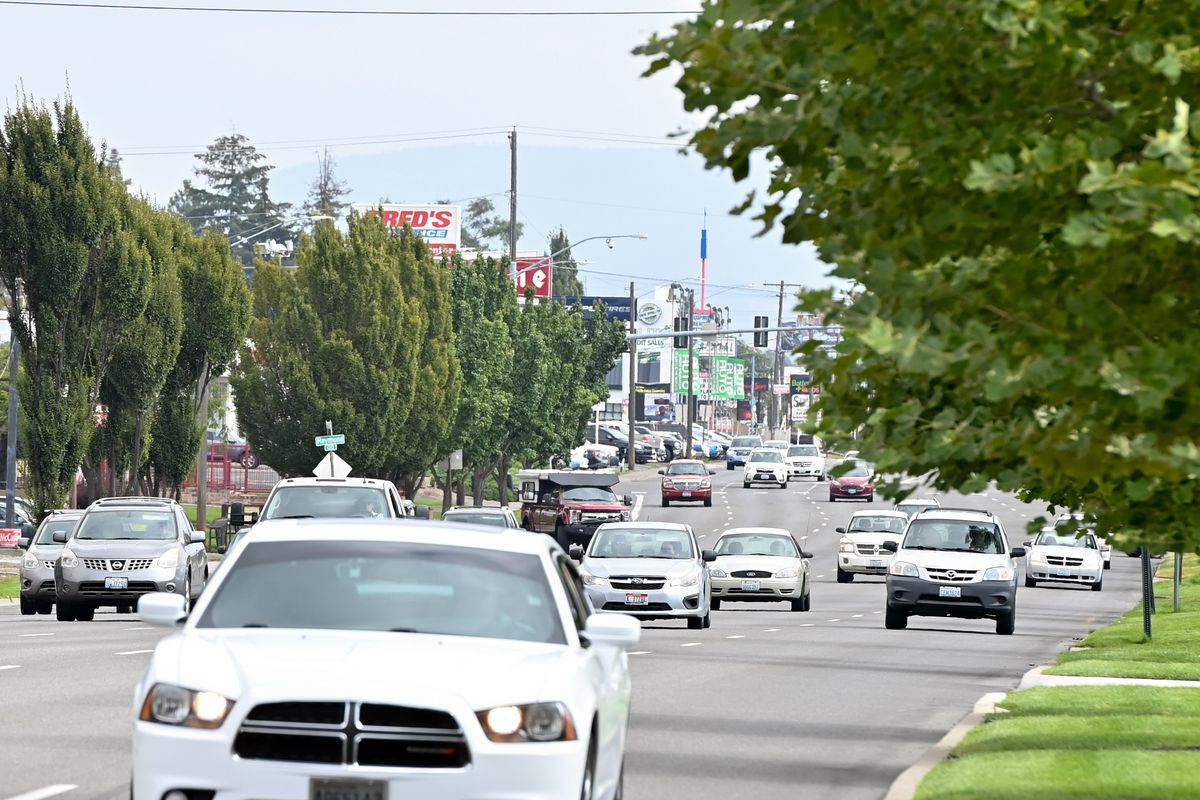Getting There: Spokane Valley pilot study to look at downsizing Sprague Avenue

Sprague Avenue has five lanes as it passes Spokane Valley City Hall.
That’s a lot of lanes for an avenue, considering they’re all heading west. Interstate 90 westbound, a mile north, gets by with four.
Traffic studies say the stretch of Sprague between University and Herald roads could still handle traffic volumes if it had three lanes instead of five. Plus, whittling the avenue down would come with big safety and environmental benefits.
Spokane Valley is beginning a pilot study on Monday to see how narrowing Sprague to three lanes for a half-mile stretch would work. The study will run through Oct. 28.
Spokane Valley City Councilman Tim Hattenburg said he supports reducing Sprague from five lanes to three.
Within the next few years, Spokane Valley will have a brand new library across the street from City Hall, Hattenburg noted. A project to expand and improve Balfour Park, adjacent to the library, could be done soon after. The Spokane Transit Authority plans to build a Balfour Park bus stop, too.
Those projects will significantly increase foot traffic and bring more kids to the area. Making Sprague safer would be wise, Hattenburg said.
Reducing the street’s lanes would slow cars down. It’s a well-documented fact that people drive faster when roads are wider and more open.
Speeding on Sprague is a significant problem, Hattenburg said. According to traffic studies, more than 60% of drivers break the speed limit on the segment of Sprague near Balfour Park, and more than 120 drivers top 50 mph on an average day.
In addition to slowing drivers down, narrowing Sprague would allow Spokane Valley to build a safer crosswalk between City Hall and Balfour Park. Pedestrians could cross Sprague seven seconds faster on average if it were two lanes skinnier, reducing the time they’re exposed on the open road. The city already has state and Spokane Transit Authority funding to build a signalized crosswalk.
Trimming down Sprague would also benefit the Spokane Valley-Rathdrum Prairie Aquifer, which provides drinking water to most Spokane and Kootenai county residents.
Today, Sprague Avenue stormwater drops into drywells and infiltrates into the aquifer without being treated. Runoff can include pollutants left atop the asphalt, such as oil.
Reducing the number of lanes on Sprague would allow Spokane Valley to install swales on either side of the road. The swales would act like sponges. They’d be full of plants that would soak up the water and clean it in the process.
According to traffic studies, the lane reduction shouldn’t worry drivers concerned about increased congestion.
The five-lane segment between University and Herald accommodates 20% of existing capacity. Based on modeling, a three-lane Sprague Avenue would handle traffic well for at least the next 18 years.
Work to watch for
Crews are installing traffic-calming features, including street and sidewalk improvements, on Southeast Boulevard at Lincoln Park.
Watch out for workers on Riverside Avenue between Cannon and Hemlock streets in the Browne’s Addition neighborhood Monday through Friday.
Cincinnati Street between Desmet and Boone avenues, and Spokane Falls Boulevard between Sherman and Pine streets, will be closed periodically in both directions this week for construction of the City Line bus rapid transit service.
Northwest Boulevard between Garland Avenue and G Street will be closed Monday from 8 a.m. to noon for a flow control test of a combined stormwater system.
In the county, 57th Avenue will be closed at Spotted Road for installation of a fire hydrant beginning Monday through Sept. 30.
U.S. Route 2 is closed at the North Fork of Deep Creek east of Reardan for installation of new bridges and realignment of the creek. A detour is in place. Work is scheduled to be complete Oct. 28.
Editor’s note: This story has been updated to reflect the correct direction of traffic on Sprague Avenue and the amount of time it would takes pedestrians to walk across a three-lane street.